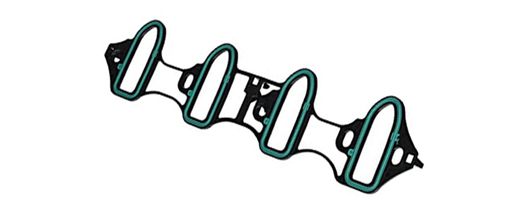Small and powerful

They may be small, but gaskets are crucial to your vehicle.Automotive gaskets are often placed between two surfaces and bolted together to act as seals to maintain fluid, maintain pressure, and prevent debris from entering the engine.Your car relies on a series of gaskets to keep it running smoothly on the road.
One of these gaskets is the intake manifold gasket.From the function of the intake manifold to the purpose of the gasket, read on for all information about the inner workings of the intake manifold gasket.
What is the intake manifold?
 The air from the outside passes through the air filter and through the ECM-assisted throttle body, which controls the airflow velocity.
The air from the outside passes through the air filter and through the ECM-assisted throttle body, which controls the airflow velocity.
 The air leaves the throttle body and enters the intake manifold chamber or body connected to the throttle body housing.
The air leaves the throttle body and enters the intake manifold chamber or body connected to the throttle body housing.
 Air passes through the vacuum created by the downward stroke of the engine's pistons in the engine's cylinder block, and from the air chamber is sucked into a set of channels called flow passages.
Air passes through the vacuum created by the downward stroke of the engine's pistons in the engine's cylinder block, and from the air chamber is sucked into a set of channels called flow passages.
 The manifold is secured to the engine cylinder head with flush bolts, and the flow passage is located above the intake valves or multiple intake valves.
The manifold is secured to the engine cylinder head with flush bolts, and the flow passage is located above the intake valves or multiple intake valves.
 As the air leaves the manifold, it mixes with fuel from the injector and sweeps into the cylinders below.
As the air leaves the manifold, it mixes with fuel from the injector and sweeps into the cylinders below.
About the intake manifold gasket
This brings us to the intake manifold gasket.The intake manifold gasket is usually made of aluminized steel coated with a carbon-based rubber mixture and seals the intake manifold to the engine.High quality intake manifold gaskets are formed in one piece with reinforced edges and lining around each port or runner opening.They must be resistant to corrosion caused by oil and coolant.Engine performance depends on the quality of the intake manifold gasket.
Symptoms of intake manifold gasket failure
If you notice any of the following symptoms, it may be a sign that the intake manifold gaskets are worn.Consult your trusted mechanic for final diagnosis and repair.

They may be small, but gaskets are crucial to your vehicle.Automotive gaskets are often placed between two surfaces and bolted together to act as seals to maintain fluid, maintain pressure, and prevent debris from entering the engine.Your car relies on a series of gaskets to keep it running smoothly on the road.
One of these gaskets is the intake manifold gasket.From the function of the intake manifold to the purpose of the gasket, read on for all information about the inner workings of the intake manifold gasket.
What is the intake manifold?
To better understand the function and form of this special gasket, let us first examine the operation of the intake manifold.The intake manifold can be found on any vehicle equipped with an internal combustion engine. It is located at the top of the engine and plays a key role in the combustion process.
Designed to run on three timing components, namely air blend fuel, spark and combustion;Internal combustion engines rely on intake manifolds to help them breathe.The intake manifold has a series of tubes to ensure that air entering the engine is evenly distributed across all cylinders.The air is used during the first stroke of the combustion process.
The intake manifold also helps cool the cylinders to prevent the engine from overheating.Coolant travels through the manifold to the cylinder head, where it absorbs heat and cools the engine.
Intake manifold design
Intake manifold design
 The air from the outside passes through the air filter and through the ECM-assisted throttle body, which controls the airflow velocity.
The air from the outside passes through the air filter and through the ECM-assisted throttle body, which controls the airflow velocity. The air leaves the throttle body and enters the intake manifold chamber or body connected to the throttle body housing.
The air leaves the throttle body and enters the intake manifold chamber or body connected to the throttle body housing. Air passes through the vacuum created by the downward stroke of the engine's pistons in the engine's cylinder block, and from the air chamber is sucked into a set of channels called flow passages.
Air passes through the vacuum created by the downward stroke of the engine's pistons in the engine's cylinder block, and from the air chamber is sucked into a set of channels called flow passages. The manifold is secured to the engine cylinder head with flush bolts, and the flow passage is located above the intake valves or multiple intake valves.
The manifold is secured to the engine cylinder head with flush bolts, and the flow passage is located above the intake valves or multiple intake valves. As the air leaves the manifold, it mixes with fuel from the injector and sweeps into the cylinders below.
As the air leaves the manifold, it mixes with fuel from the injector and sweeps into the cylinders below.About the intake manifold gasket
This brings us to the intake manifold gasket.The intake manifold gasket is usually made of aluminized steel coated with a carbon-based rubber mixture and seals the intake manifold to the engine.High quality intake manifold gaskets are formed in one piece with reinforced edges and lining around each port or runner opening.They must be resistant to corrosion caused by oil and coolant.Engine performance depends on the quality of the intake manifold gasket.
Symptoms of intake manifold gasket failure
If you notice any of the following symptoms, it may be a sign that the intake manifold gaskets are worn.Consult your trusted mechanic for final diagnosis and repair.
Vehicle coolant leakage
Engine overheating
There are green, red or yellow leaks under the car
Check that the engine light is on
The engine began to stall
Consequences of gasket failure
The engine and gasket are designed to last between 50,000 and 75,000 miles in heat, and expanding and contracting can cause them to fail.If the intake manifold gasket fails, coolant may leak from the manifold.As the engine loses coolant, it can overheat because it can no longer cool itself properly.If not resolved in time, the problem may cause permanent damage to the engine block and cylinder.Consequences of gasket failure
